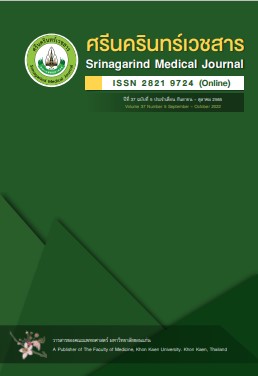การศึกษาปริมาณรังสีที่ผู้ป่วยได้รับบริเวณเลนส์ตาจากการตรวจสมองด้วยเครื่องเอกซเรย์คอมพิวเตอร์ 64 และ 128 สไลซ์
คำสำคัญ:
ปริมาณรังสี, เลนส์ตา, เครื่องเอกซเรย์คอมพิวเตอร์, อุปกรณ์วัดรังสีโอเอสแอล นาโนดอทบทคัดย่อ
วิธีการศึกษา: ติดอุปกรณ์วัดรังสีโอเอสแอลชนิด นาโนดอท (nanoDot) ที่เปลือกตาทั้ง 2 ข้างของผู้ป่วยที่เข้ารับการตรวจสมองด้วยเครื่องเอกซเรย์คอมพิวเตอร์ 64 สไลซ์ (19 ราย) และ 128 สไลซ์ (19 ราย) เพื่อวัดค่าปริมาณรังสีที่เลนส์ตาของผู้ป่วย
สรุป: ปริมาณรังสีเฉลี่ยที่ผู้ป่วยได้รับบริเวณเลนส์ตาจากการตรวจสมองด้วยเครื่องเอกซเรย์คอมพิวเตอร์ 64 สไลซ์และ 128 สไลซ์ มีค่าไม่เกินเกณฑ์ต่ำสุดที่จะทำให้เกิดต้อกระจกหรือเลนส์ตาขุ่นมัว ดังนั้น การใช้อุปกรณ์ป้องกันอันตรายจากรังสีจำเป็นต้องพิจารณาถึงตำแหน่งของการถ่ายภาพเพื่อไม่ให้บดบังอวัยวะที่ต้องการถ่ายภาพ
เอกสารอ้างอิง
Omer H, Alameen S, Mahmoud WE, Sulieman A, Nasir O, Abolaban F. Eye lens and thyroid gland radiation exposure for patients undergoing brain computed tomography examination. Saudi J Biol Sci. 2021;28(1):342-6.
Adult Routine Head CT Protocols 2.0. Approved by American Association of Physicists in Medicine on March 1, 2016. American Association of Physicists in Medicine. [Cited May 2, 2022]. Available from: https://www.aapm.org/ pubs/ctprotocols/documents/adultroutineheadct.pdf
Jaffe TA, Hoang JK, Yoshizumi TT, Toncheva G, Lowry C, Ravin C. Radiation dose for routine clinical adult brain CT: Variability on different scanners at one institution. Am J Roentgenol 2010;195(2):433-8.
Julien S, Mueangsawang S. Assessment of radiation dose in computed tomography for routine brain and abdomen examinations. J Health Sci 2017;22(6):1035-41.
Gu J, Shi HS, Han P, Yu J, Ma GN, Wu S. Author Correction: Image quality and radiation dose for prospectively triggered coronary CT Angiography: 128-slice single-source CT versus first-generation 64-slice dual-source CT. Sci Rep 2020;10(1):11619.
Stewart FA, Akleyev AV, Hauer-Jensen M, Hendry JH, Kleiman NJ, MacVittie TJ, et al. ICRP PUBLICATION 118: ICRP Statement on tissue reactions and early and late effects of radiation in normal tissues and organs — Threshold doses for tissue reactions in a radiation protection context. Ann of the ICRP 2012;41(1-2):1-322.
ICRP. 2012 ICRP Statement on tissue reactions / early and late effects of radiation in normal tissues and organs – Threshold doses for tissue reactions in a radiation protection context. ICRP Publication 118. 2012;41.
Alwasiah R, Jawhari A, Orri RA, Khafaji M, Al Bahiti S. Measurement of radiation dose to the eye lens in non-enhanced CT scans of the brain. Radiat Prot Dosimetry 2021;195(1):56-60.
Kuepitak K, Thananon J, Awikunprasert P, Sangsawang S, Rueangsitrakoon J, Pungkun V, et al. The study of radiation dose and radiation scattering from computed tomography in a model. J Med Health Sci 2019;26(1).
Phaorod J, Wongsanon W, Hanpanich P, Dornsrichan P, Awikunprasert P, Sriwicha J, et al. The Measurement radiation doses to the lens of eye and thyroid gland from computed tomography brain scans and radiation dose around in CT scan room: phantom study. Srinagarind Med J 2020;35(2):153-60.
ดาวน์โหลด
เผยแพร่แล้ว
รูปแบบการอ้างอิง
ฉบับ
ประเภทบทความ
สัญญาอนุญาต
ลิขสิทธิ์ (c) 2022 ศรีนครินทร์เวชสาร

อนุญาตภายใต้เงื่อนไข Creative Commons Attribution-NonCommercial-NoDerivatives 4.0 International License.




